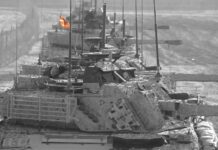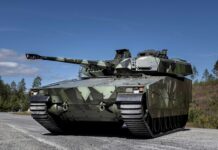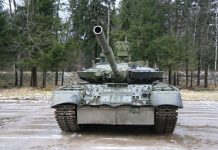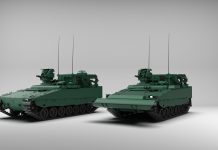Armed forces continue to pursue active protection systems (APSs) capable of effectively defeating anti-armour weaponry. As many different designs have completed their development, the current APS market offers users more options than ever before.
The high numbers of damaged or destroyed armoured vehicles suffered by the warring parties in the Ukraine War underscores the urgent need for improved vehicle protection. Adding more and better armour is one possible approach, but the increased weight and bulk invariably interfere with mobility and add stress to the chassis and drivetrain. For years, users and industry have pursued APSs as an alternative or adjunct to additional armour. Like armour, APSs are intended to protect the vehicle on which they are mounted, although protection of nearby vehicles is being examined as a further capability enhancement. Unlike armour, however, they are designed to intercept or divert incoming anti-tank ordnance before impact – a so-called ‘left of boom’ approach.
APSs are generally divided into two categories: hard-kill and soft-kill. The majority of APSs are hard-kill systems. These typically work by using an explosive effector to defeat the incoming anti-tank projectile, detonating in close proximity to it in order to destroy or deflect it, and thereby minimising its effect on the protected vehicle. This can be achieved in several ways.
One common approach for hard-kill APSs is to use one or more rotating launchers armed with small interceptor grenades on the host vehicle, which launching a projectile at the incoming threats to defeat it at a distance from the vehicle. Examples of this type of APS include the Elbit Systems Iron Fist and the Aselsan Akkor. Another approach is to use distributed static effectors all around the vehicle, which detonate to defeat the threat when it is very close to the vehicle. Examples of this type include Mikrotek Zaslon (along with the Aselsan Pulat based on the Zaslon design) and the Rheinmetall Strikeshield. This latter approach relies more on passive armour to absorb residual blast and fragmentation, however, it can be particularly advantageous in urban or forest environments with limited line-of-sight to conduct interceptions further from the vehicle.
Soft-kill APSs utilise a variety of methods to divert an incoming missile from its target without actually intercepting the weapon. These can be as simple as deploying a smoke screen, to jamming semi-automatic command to line-of-sight (SACLOS) guided projectiles. More complex approaches utilise electronic warfare (EW) technology to disrupt radar-based seekers, or laser ‘dazzlers’ to blind optically-guided munitions.
North American developments
The US armed forces have displayed great interest in acquiring APSs for their various armoured vehicles, most notably the M1 Abrams main battle tank (MBT), the M2 Bradley infantry fighting vehicle (IFV) and Stryker infantry carrier vehicle (ICV) families. However, very few US firms are developing their own active protection systems. This was not always the case – during the early-mid 2000s, interesting efforts such as Raytheon’s ‘Quick Kill’ and US branch of BAE Systems ‘IAAPS’ and ‘CICM’ APSs, among various others, were in development. However, ultimately none of these designs progressed to entering service. As such, most APS solutions now under consideration by the Pentagon are foreign designs, such as Rafael’s Trophy system, which is being integrated onto the Abrams MBT by Leonardo DRS.
Artis – Iron Curtain
One exception to the foreign technology trend is Virginia-based Artis LLC, which began developing the Iron Curtain APS in 2004. This distributed hard-kill system was tested on the M-ATV MRAP and the Humvee, and was provisionally selected as an interim solution for the Stryker in 2016. However, the Army dropped it from consideration in August 2018 following evaluation trials on the Stryker. According to Army statements at the time, the Iron Curtain was generally considered viable and was able to hit its targets, but lacked adequate maturity; the service was unwilling to invest the time and resources necessary to bring it up to speed. A 2019 Army statement clarified that the system remains a viable option for future consideration.
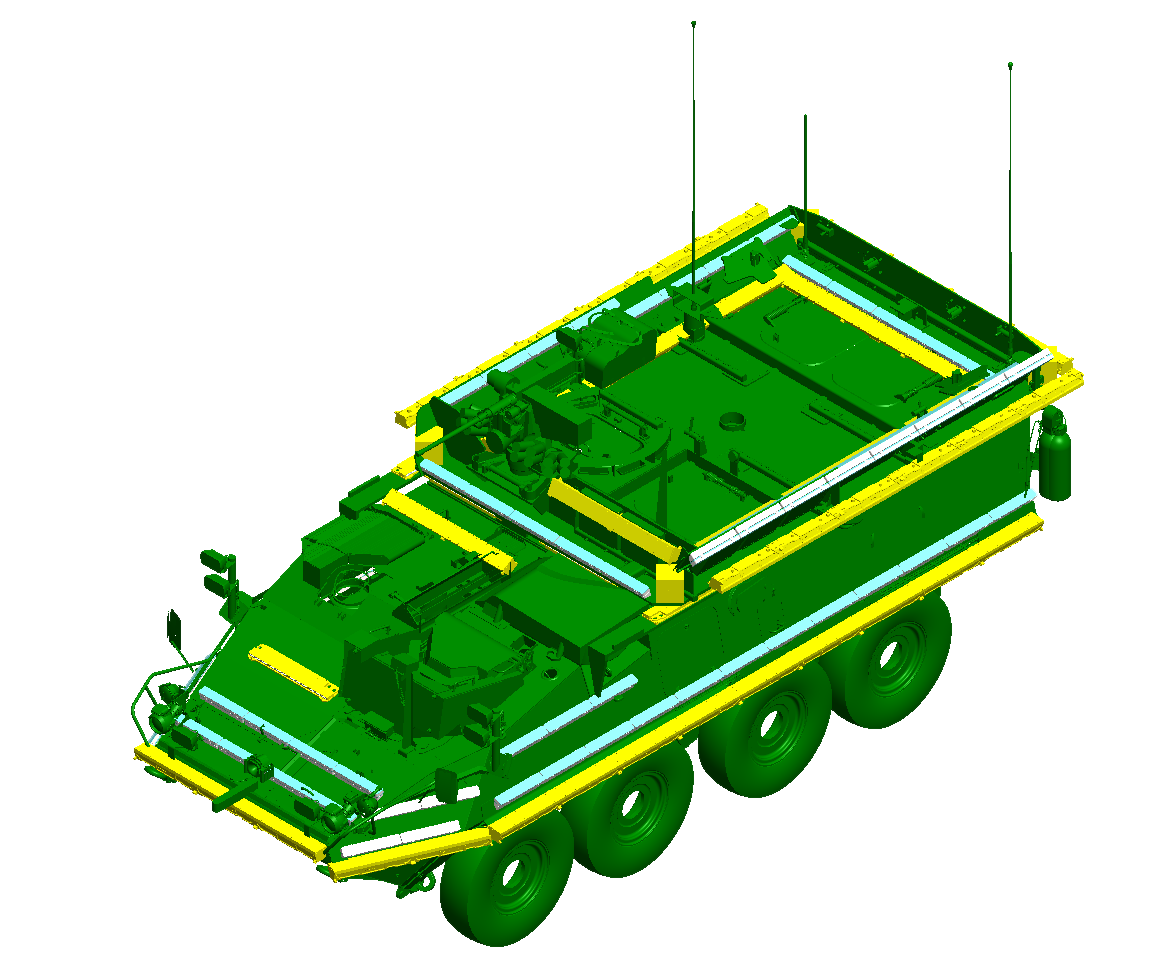
Credit: Artis
In the meantime, the firm has pursued an upgraded version dubbed the Improved Iron Curtain or I2C, which offers enhanced performance while reducing size, weight, power consumption and cost (SWAP-C). The modular, shelf-like components can be mounted on any vehicle frame, as well as on buildings or other infrastructure, to provide protection from top- and side-attack. The system is effective against rocket propelled grenades (RPGs) and anti-tank guided missiles (ATGMs). I2C detects incoming projectiles via radar and initiates the countermeasure when the threat is only centimetres from the vehicle. The system includes both upward-firing and downward-firing effectors, an arrangement which allows for protecting against both direct-fire projectiles as well as some types of top-attack projectiles. By engaging the threat at a very short distance from the vehicle, this arrangement also reduces the risk of injury to dismounted personnel or civilians who could otherwise be in the line of fire. The system is also intended to deflagrate rather than detonate the warhead of incoming shaped charge threats, to further reduce the risk of collateral injuries.
Lockheed Martin – MAPS
Artis states that the I2C is compatible with the modular active protection system (MAPS) being developed by Lockheed Martin Missiles and Fire Control as part of the US Army’s overarching future vehicle protection system (VPS). MAPS is conceived as an open architecture system with a common controller to be mounted on various combat vehicles. It will be capable of simultaneously integrating various hard- and soft-kill countermeasure technologies, including the interim measures such as Trophy and Iron Fist currently being pursued. It is designed to adapt over time in order to accommodate vehicle development as well as incorporate new defensive technologies as they mature.
As described by Lockheed Martin, the firm’s MAPS base kit integrates sensors and countermeasures in an open, common framework to detect, track, classify and defeat existing and emerging threats such as RPGs and ATGMs. The open and scalable architecture provides the ability to exchange individual components of a vehicle protection system rather than replace an entire configuration. This will enable faster and cheaper upgrades by replacing only those elements which need to be exchanged in order to counter new threats. The open architecture will permit interfacing components from various developers without proprietary restrictions. The MAPS common controller, with its high-speed processor and the associated software (which identifies the incoming threat and selects the optimal countermeasure) form the heart of the system. Acquisition and tracking sensors, as well as active countermeasures, interface with the controller. The precise configuration – including the type, number and arrangement of sensors and effectors – will be optimised for each vehicle type.
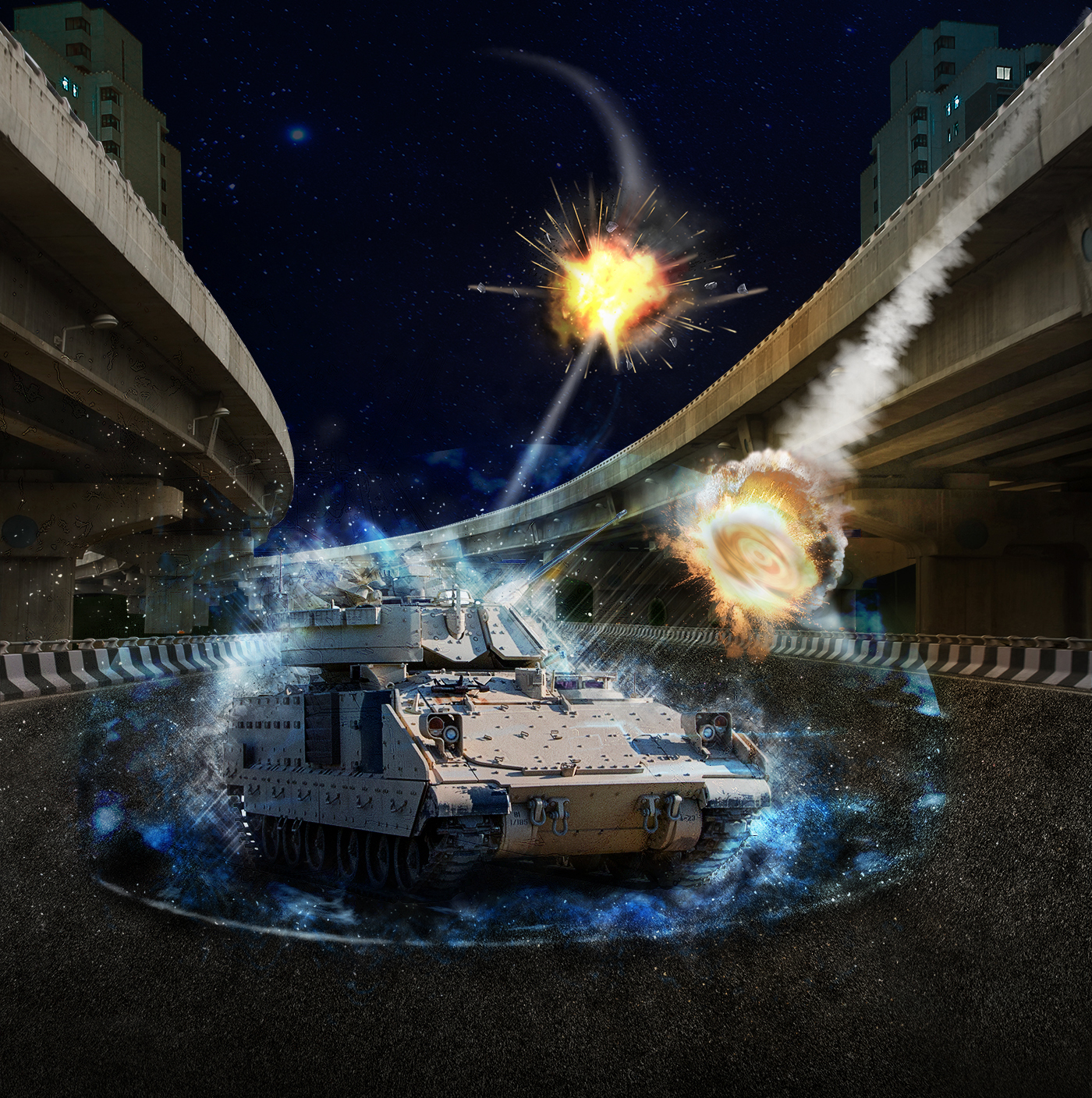
Credit: Lockheed Martin
Development of MAPS began in 2014. Following successful live-fire tests, in February 2021 the US Army awarded Lockheed Martin a three-year, USD 30 million contract to integrate and test the MAPS kit on four classes of combat vehicles: the Abrams MBT, the Bradley IFV, the Armoured Multi-Purpose Vehicle, and the Stryker. The contract also covers developing base kit support beyond APS, such as underbelly blast protection. The integration and test phase is expected to be followed by a production decision. A precise timeframe for serial fielding of the operational system has not been announced.
European manufacturers
Several European firms have presented APSs which are either operational or in advanced stages of development.
Rheinmetall – StrikeShield
StrikeShield is the newest iteration of Rheinmetall’s established advanced modular armor protection – active defense system (AMAP-ADS) family. The StrikeShield system completed more than 900 successful intercept tests before serial production began in September 2021. The modular, scalable system can be applied to vehicles of nearly every weight class, including 4×4s, transport trucks, IFVs and MBTs. System weights range from 100 kg to 1 tonne, depending on the configuration. The distributed APS consists of multiple radars, optical sensors, and effectors per protected vehicle. The precise number and ratio of the components varies with the vehicle and the level of protection desired by the user.
According to Rheinmetall, the system is optimised for simultaneous intercept of multiple RPGs and ATGMs, including some top-attack munitions and “certain types of IED”. The reaction time between detection and engagement of incoming ordnance is 560 microseconds; Rheinmetall describes this as the shortest reaction time of any APS in ambush and multi-attack scenarios. Incoming missiles are engaged within close proximity to the protected vehicle. Instead of launching projectiles, the StrikeShield uses a directed blast to degrade or destroy the incoming warhead, with residual blast energy and fragmentation from the warhead absorbed by the vehicle’s passive armour.

Credit: Rheinmetall
One special advantage of StrikeShield is the extremely small electromagnetic signature of the low-power radar sensors. This decreases the risk of detection of the radars – and the vehicle – by hostile electronic intelligence (ELINT) assets. According to Rheinmetall, some currently deployed APS radars can be detected from a distance of 21.5 km, while StrikeShield’s low emissions limit the detection range down to roughly 350 m (at -60 dBm sensitivity) for tactical level ELINT assets, or 6 km (at -95 dBm sensitivity) for more powerful strategic-level ELINT assets.
The hard-kill StrikeShield system can be combined with Rheinmetall’s Rapid Obscuring System (ROSY) soft-kill obscurant smoke solution (which can defeat munitions guided by TV or infrared homing, and semi-active laser (SAL) guidance systems) for an integrated protection solution. In addition to the standard variant of Strikeshield, Rheinmetall has also devised a hybrid StrikeShield system which integrates active protection and passive armour. In this configuration, the APS components are embedded between the outer and inner tiles of the passive spaced armour, while radar and optronic sensors are placed between the tiles. This affords the active components a degree of protection from small arms fire and shell fragments. These hybrid tiles are lighter in weight than typical passive armour plates, but offer protection against a greater range of threats due to the APS component. The first procurement contract was issued in May 2021 by Hungary, which ordered 209 sets of the hybrid protection kit to be mounted on its Lynx IFVs.
Hensoldt MUSS
In contrast to StrikeShield, the multifunctional self-protection system (MUSS) produced by Hensoldt is a soft-kill APS. With 350 units delivered to the German Bundeswehr for deployment on Puma IFVs, MUSS is one of the few soft-kill APS to be operational on a larger scale. In 2021, Hensoldt announced development of the next-generation system, MUSS 2.0, which will introduce new sensors and enhanced processing power to detect and overcome current and emerging threats. MUSS is designed to protect medium-weight and heavy armoured vehicles including self-propelled artillery, IFVs and MBTs; the system weighs up to 170 kg, considerably less than most hard-kill systems on such vehicles. The layered MUSS APS is effective against both SACLOS and SAL guided munitions.

Credit: Hensoldt
The system has multiple components geared to deal with various threats. Each vehicle is equipped with a central electronic control unit and four passive sensor heads. Each sensor head contains both an infrared (IR) based ATGM warning sensor (with a range of several kilometres) and a laser warning sensor; MUSS does not employ radar. Countermeasures controlled by the central unit include an infrared (IR) jammer mounted high on the vehicle to ensure 360° coverage, and an adjustable smoke and pyrotechnic ammunition dispenser, all intended to either break a targeting lock or divert incoming munitions.
Enhancements introduced through the 2.0 upgrade include enhanced laser detection capability in the presence of obscurants and of low-energy laser threats; expansion of the threat detection portfolio to now include RPGs, tracer ammunition, muzzle flash, and kinetic energy munitions; multi-threat capability and threat prioritisation; and a more favourable space, weight and power (SWAP) ratio which will make the system viable for smaller vehicles. Future enhancements are likely to include laser dazzlers.
Thales – Diamant
Thales Group is developing a new distributed hard-kill APS called Diamant which is currently undergoing testing by the French defence ministry’s procurement agency, Direction Générale de l’Armement (DGA). The evaluation is being conducted under the French MoD’s Protection Multi Effets Terrestre Unifiée (PROMETEUS) programme to develop an ASP for the future Scorpion combat vehicle series. A Griffon Véhicule Blindé Multi-Rôle (VBMR) multirole armoured vehicle is serving as the test platform.
The Diamant APS uses four frequency-modulated continuous wave (FMCW) radar sensors mounted on the corners of the vehicle roof, and a number of effector modules mounted on frames around the perimeter of the vehicle roof and bonnet (22 interceptors as configured on the Griffon). Incoming projectiles are detected at close range, and engaged by a directed effector when they are in close proximity to the vehicle. The reaction time to initiate an intercept is less than 0.1 seconds. The system works by launching a directional blast into the path of the threat. To date, the system has intercepted RPGs and ATGMs with the Griffon test platform driving at speeds up to 70 kmh.
Middle Eastern systems
Rafael – Trophy
The Trophy system produced by Rafael Advanced Defense Systems is arguably the most well-known APS in the world. In service with the Israeli Defense Forces (IDF) since 2009, its effectiveness in combat was proven in 2011. It has now accrued over 1 million operating hours, with 1,800 units delivered or under contract.
Rafael’s APS is currently offered in two variants. Trophy HV (heavy vehicle) is based on the original system, designed for medium-to-heavy armoured vehicles such as MBTs and 8×8 or tracked IFVs. The full system weighs 820 kg, with a 0.69 m³ footprint on the vehicle. Trophy VPS, the lighter variant, is currently in the final stages of development following field testing in Israel and overseas. Configured for medium to light armoured vehicles, it is 40% lighter than the original variant, but provides the same level of protection. VPS is designed to integrate additional technology in the future.
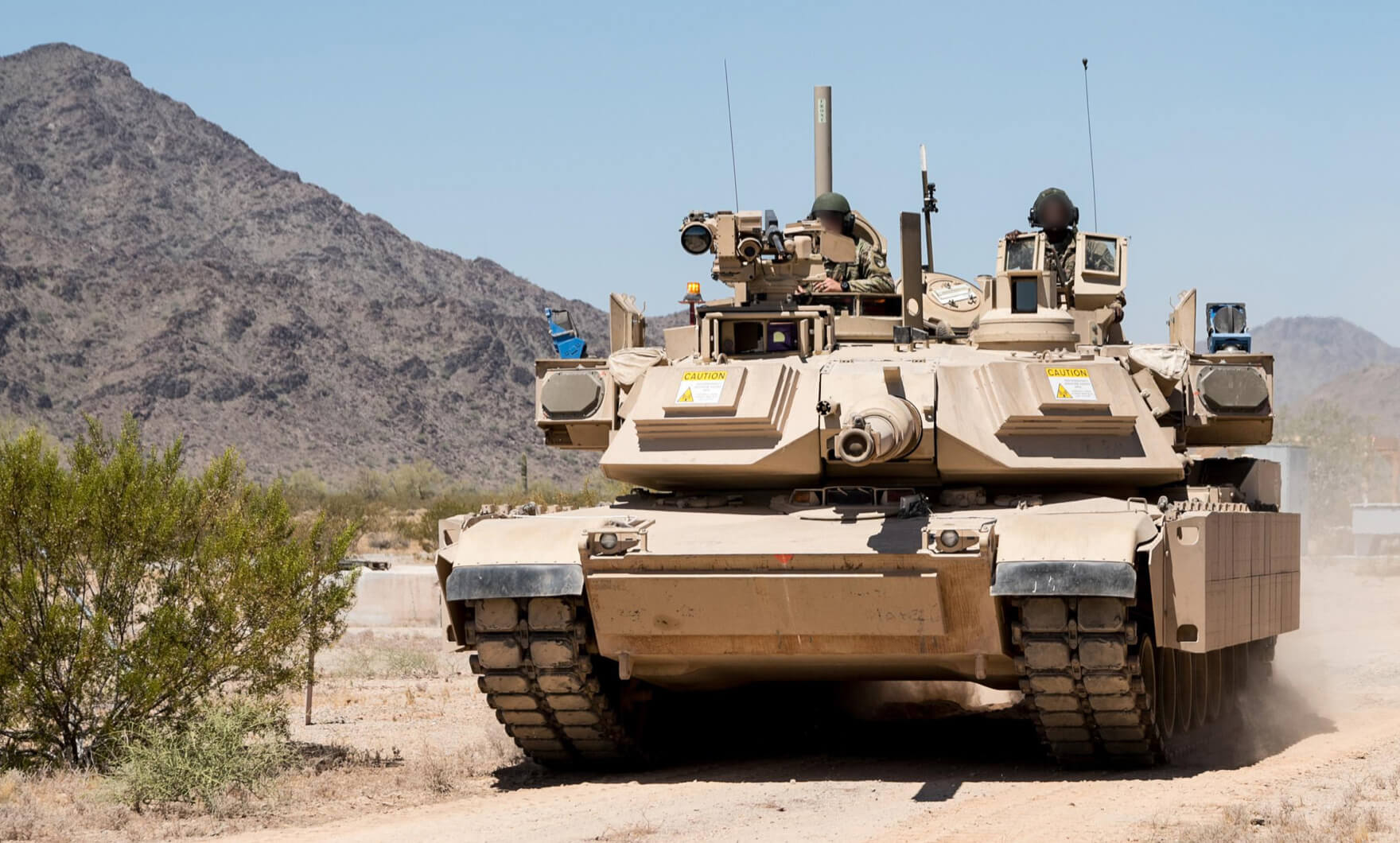
Credit: Rafael
Trophy uses a relatively unique effector among APSs, using a flat plate effector containing multiple small explosively formed penetrators (EFPs). This plate is detonated, which effectively launches the small EFPs into the path of the incoming munition, in a similar pattern to a shotgun blast. This is designed to destroy the threat at some distance from the vehicle (potentially at a range of 10 m or more). It offers 360° protection against multiple and near-simultaneous attack by RPGs, rockets, ATGMs, and high explosive anti-tank (HEAT) rounds. The system’s radar (optionally augmented by optronic sensors) detects and tracks the incoming threats while the control element computes a fire solution. If tracking determines a missile will miss the protected vehicle, Trophy will not fire in order to preserve effectors. IR countermeasures can be integrated into Trophy to provide a soft-kill option.
The complete Trophy system combines the APS with a hostile fire detection (HFD) system to enable the crew to rapidly locate and neutralise threat sources. The HFD system is networked, providing the threat location to the protected vehicle’s battle management system, which can respond with onboard weapons or pass the data to other networked platforms, enabling other friendly vehicles to engage the threat. On IFVs, the Trophy can be integrated with the Samson 30 remote weapon station, which can be slewed to engage detected enemy firing positions with the 30 mm gun, coaxial machine guns, or Spike ATGMs.
Rafael’s partner Leonardo DRS supports testing and export of the APS. In January 2021, Leonardo completed delivery of four brigade-sets to the US Army, to equip 400 Abrams M1A2 SEPv2 and SEPv3 MBTs. That same year, the British Army announced plans to equip the Challenger 3 MBT with Trophy (delivery 2027–2030). In 2022, the EuroTrophy joint venture was founded by General Dynamics European Land Systems, Krauss-Maffei Wegmann and Rafael. In September 2023, Rafael announced that Trophy would be the baseline APS on the new Leopard 2A8 which, to date, is on order by the German and Norwegian armed forces. South Korea has also opted for Trophy as an option for variants of the K2 Black Panther MBT.
Elbit Systems – Iron Fist
Another internationally successful Israeli APS is the Iron Fist, produced by Elbit Systems. The system is available in two configurations. According to Elbit, the Iron Fist Light Decoupled (IFLD) variant is designed for light to medium IFVs as well as logistics vehicles and 4 × 4 tactical vehicles; it is capable of defeating RPGs, rockets, recoilless rifle rounds, as well as ATGMs. The Iron Fist Light Kinetic (IFLK) is intended for MBTs and heavy IFVs; it defeats rockets, ATGMs, recoilless rifle munitions, as well as HEAT rounds, armour-piercing fin-stabilised discarding sabot (APFSDS) rounds, and even loitering munitions, (provided these are not diving on their target at too steep an angle).
The effectors are carried in double-barreled launchers capable of traverse and elevation, with most configurations using two launchers to provide 360° coverage. Iron Fist employs a grenade-type effector which explodes in close proximity to the threat projectile in order to defeat it. In the case of APFSDS rounds, the interceptor’s blast introduces a degree of yaw onto the projectile, forcing it to impact the vehicle at a less-effective angle, losing much of its penetrative capability in the process. An optional soft-kill anti-ATGM laser jammer can be integrated with the interceptor system. Threat detection and tracking are achieved through independently operating radar and passive IR sensors, with a detection range of 1.5 km.
Iron Fist has been selected for the IDF’s Eitan IFV, D9 armoured bulldozer, and the turreted variant of the Namer IFV. BAE Systems Hägglunds has integrated Iron Fist on the CV90 armoured combat vehicle. Both the Dutch and the Czech armies have opted to include the system on their CV90 fleets, while the Australian army has selected it for their Boxer 8×8 combat reconnaissance vehicle (CRV). The US Army completed testing of the IFLD on the Bradley IFV in late-2022, and plans to equip a brigade’s worth of vehicles with the system by 2025. For the latter project Elbit has partnered with General Dynamics – Ordnance and Tactical Systems (GD – OTS).

Credit: Elbit Systems
Advantage multitasking
New anti-armour threats are evolving, including armed unmanned aerial vehicles (UAVs) and loitering munitions capable of top-attack. Ground- and air-launched ATGMs with greater range and speeds (potentially even hypersonic) are being developed. Saturation attacks by comparatively low-cost weapons threaten to overwhelm defences or simply run out hard-kill APS magazines. In the long run, one-size-fits-all solutions to vehicle defence will be inadequate. The trend towards hybrid APSs is already recognisable, integrating hard- and soft-kill techniques or linking APS sensors with offensive weapons in order to destroy enemy firing positions rather than gamble on the ability to intercept the next ATGM, and the next one after that. While any functioning APS provides a vital extra layer of survivability to a combat vehicle, the future will belong to systems that simultaneously provide multiple different means of defence.
Sidney E. Dean




